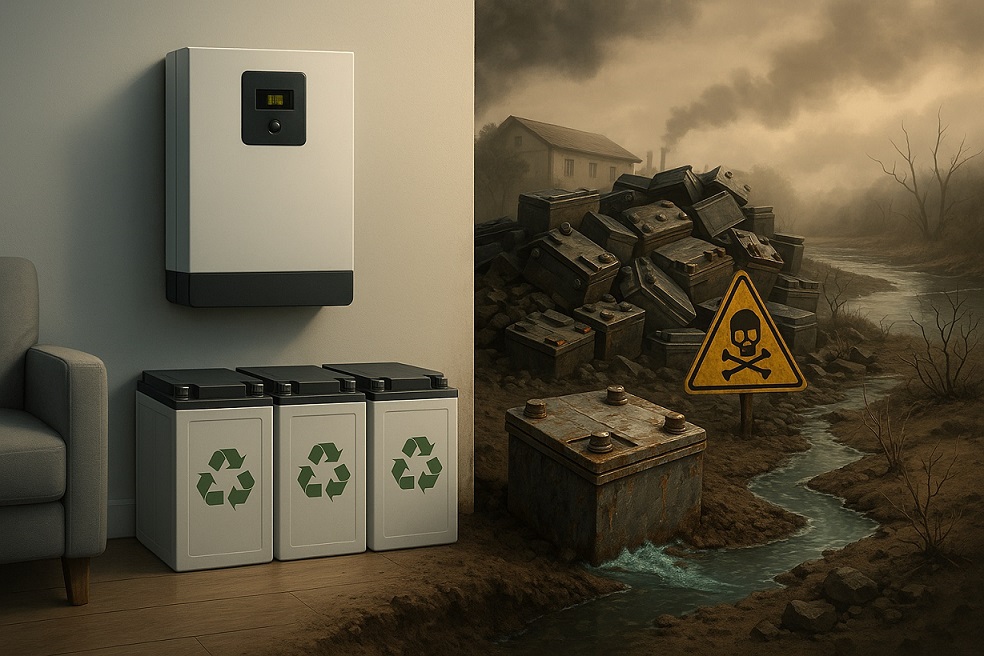Let’s be honest—most of us don’t really think about what powers our inverters or solar setups. We just want the lights to stay on when the grid fails, right? But what if the very thing keeping our homes running during outages is also harming the environment?
The truth is, batteries and pollution are more connected than people realize. And if you’re still relying on old-school lead-acid batteries, the problem might be closer to home than you think.
Let’s dig into the lesser-known impact of backup batteries, how they contribute to environmental damage, and why Lithium Batteries are now leading the way as a cleaner, smarter alternative.
The Hidden Cost of Powering Up
Backup batteries—especially lead-acid ones—have long been the go-to choice for inverters and emergency power systems. They’re affordable, available just about everywhere, and they work.
But here’s the problem: they come with a heavy environmental price tag. These batteries contain lead, sulfuric acid, and other toxic materials that can leach into soil and water if not disposed of properly. Unfortunately, improper recycling and disposal are common in many parts of the world, including India, due to the lack of regulation and public awareness.
It doesn’t end there. Even the manufacturing and recycling processes of lead-acid batteries often involve unsafe handling practices, leading to air pollution, water contamination, and serious health risks for workers.
So, the connection between batteries and pollution is clear—and it starts the moment that battery is made.
Pollution You Don’t See
What makes this issue even trickier is how invisible it all seems. Unlike a smoky exhaust pipe or a littered beach, you don’t see a backup battery harming the environment. It sits quietly under the stairs, in a corner, doing its job.
But when these batteries are overcharged, damaged, or eventually disposed of (usually every 2–3 years), they begin to release harmful substances. Lead and acid residues find their way into landfill runoff. In many informal recycling setups, fumes from melting battery parts get released into the air. Over time, this contributes to widespread pollution, much of which goes unnoticed.
In short, your backup power system might be silently polluting the very world it’s meant to support.
Enter Lithium Batteries: A Greener Alternative
Thankfully, we’re no longer stuck with outdated options. Inverter Lithium Batteries are changing the game for backup power—and they’re a much cleaner alternative in nearly every way.
Here’s why Lithium Batteries are better for the environment:
- No toxic lead or acid: This eliminates the risk of ground and water contamination.
- Longer lifespan: With a usable life of 7–10 years (or more), lithium batteries reduce the volume of waste created from frequent battery replacements.
- Better energy efficiency: Less energy loss during charge/discharge means lower overall electricity use.
- Recyclable and safer: As recycling infrastructure improves, Lithium Batteries can be safely repurposed or recycled without the toxic risks associated with lead-acid models.
They’re also maintenance-free, lightweight, and much easier to install—especially for residential users who don’t want to deal with acid leaks or regular water top-ups.
Rethinking How We Store Power
The shift toward Lithium Batteries is not just a tech trend—it’s a necessary step toward environmental responsibility. As solar energy becomes more common, and as inverter systems continue to grow in popularity, choosing the right battery matters more than ever.
By making the switch, you’re not just upgrading your home—you’re actively helping reduce the connection between batteries and pollution.
Imagine the impact if every household replaced their old inverter battery with a cleaner lithium-based one. Less toxic waste. Less soil and water contamination. Cleaner air. And a smaller carbon footprint overall.
Final Thoughts: One Small Switch, Big Impact
We don’t always get to control the way electricity is generated, but we do get to choose how we store it.
Backup batteries are essential—but they don’t have to be harmful. If you’re still relying on outdated lead-acid models, now’s the time to rethink your setup. Upgrading to Lithium Batteries is not just a smart move—it’s the responsible one.
It’s a small switch in your home that can make a big difference for the planet.
So next time your inverter kicks in, ask yourself: What’s powering it—and what’s the impact?
The future of energy is clean, efficient, and sustainable. And with Lithium, it’s already here.

